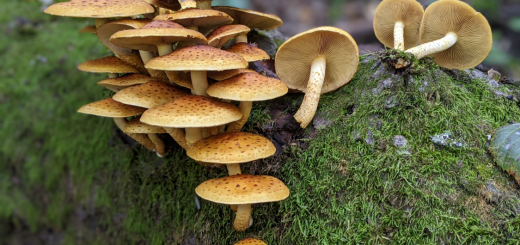#207: Ergot Alkaloids
Ergot Alkaloids (EAs) belong to a large class of mycotoxins. They are primarily produced by fungi in the genera Claviceps and Epichloë, although Claviceps purpurea is responsible for most of the impacts on humans. EAs are most common in rye, but can be found in any cereal grain. The toxins were a significant problem in the middle ages, but modern agricultural techniques mean that exposure to enough EAs to cause symptoms is extremely rare.1,2
Sources
Many fungi produce ergot alkaloids in many different plant hosts. Humans are impacted most by species of Claviceps, which infect seeds of grasses. The most problematic species is C. purpurea (see FFF#061), which infects rye. A variety of other species infect cereal grains but cause less contamination. Livestock can be sickened by infected grain or by ergot alkaloids produced by endophytes in pasture grasses, most notably by Epichloë coenophiala.1–3 This post focuses on Claviceps and cereal grains, since endophytes were covered in FFF#115.
Claviceps spp. infect seeds and leave the rest of the plant alone. The life cycle of the fungus begins in the spring – usually during wet weather – when a spore lands on the flower of a grass. The fungus infects the flower, growing into the flower’s ovaries. There, it begins altering the flower’s metabolism, causing the seed tissues to grow unusually fast. As the modified seed packed with fungal tissue grows, the fungus produces asexual spores that can infect other nearby flowers. At harvest time, the modified seed is much darker and longer than it should be. This structure is called an “ergot” and is composed of both fungal and plant tissue. As winter approaches, the ergot drops to the ground. The fungus overwinters inside the ergot, protected by the thick, dark outer layer. The next spring, the fungus produces short, lollipop-like structures that produce sexual spores. These spores infect new flowers to continue the disease cycle.3
Structure and Mechanism
The ergot alkaloids form a large class of molecules. There are 12 main disease-causing EAs found in human food, but many more variations exist.1,4 All EAs are derived from the amino acid tryptophan and based on the structure of ergoline. Ergoline is based on a 16-atom chain folded into four rings. Ergot alkaloids primarily differ in the groups of atoms attached to the eighth atom in the chain and whether there is a double bond between atoms 8 and 9 or between 9 and 10. Based on the atom groups attached to atom 8, chemists distinguish four broad groups of ergot alkaloids: clavine alkaloids, simple lysergic acid derivatives, ergopeptine alkaloids, and ergopeptam alkaloids.1
Clavine alkaloids are the simplest ergot alkaloids. They tend to be smaller and are produced from precursors to lysergic acid such as agroclavine. Simple lysergic acid derivatives are based on lysergic acid and have relatively short atom chains attached at atom 8. Ergopeptine alkaloids have complex amino acid loops attached at atom 8, while ergopeptam alkaloids have amino acid chains attached at atom 8.1
Most ergot alkaloids are chiral molecules. Chiral molecules have right-handed and left-handed forms but share the same chemical formula. In other words, there are two different ways to assemble the molecule that result in molecules that are mirror images of each other. This may not seem like a significant difference, but for ergot alkaloids, this slight difference determines how strongly the molecule causes symptoms. Compounds based on the D- form of lysergic acid are most active, while the others do not interact with receptors and are therefore harmless or are only mildly harmful. However, the ergopeptine and ergopeptam alkaloids can easily switch between the active and inactive forms, meaning both forms are potentially harmfull.1
Ergot alkaloids cause symptoms by activating various neurons, primarily by binding to serotonergic, adrenergic, and dopaminergic receptors (these receptors bind serotonin, adrenaline, and dopamine, respectively). The chemicals that usually bind those receptors do not look very similar to EAs, so EAs do not bind the receptors very well and are not very picky about which receptors they bind. On top of that, each EA has a slightly different structure, so each one interacts with these receptors in a slightly different manner. Since the relevant receptors are distributed among many different systems across the body, they symptoms of EA poisoning vary greatly depending upon the precise blend of EAs ingested.1
Symptoms
The disease caused by ingestion of ergot alkaloids is now known as “ergotism” and is rare. However, in medieval Europe the disease was a common disease of the poor and was called ignis sacer (“holy fire”) or “St. Anthony’s Fire.” Bad weather preceded large-scale outbreaks of the disease, which was primarily caused by C. purpurea growing on rye (a staple food for the poor). Symptoms were variable due to age, amount of toxins consumed, and the specific ratios of EAs. [For more on the history of ergotism, see FFF#061] Accounts from medieval Europe and more modern outbreaks demonstrate that EA-infected grain causes two types of ergotism: gangrenous and convulsive.1,5
Gangrenous ergotism is the more destructive of the two forms. It is characterized by severely restricted blood flow to the extremities. Initially, this causes swelling and a severe burning sensation in the limbs. In severe cases that are not treated, gangrene develops and blood flow to the affected extremity completely stops. The extremity – often a foot – dies, dries out, and then falls off at a joint. Despite the horrific nature of the final stage of gangrenous ergotism, the mummified area separates without any pain or bleeding.1,5
Convulsive ergotism causes muscle spasms and convulsions of the entire body that recur periodically over a period of a few days. During this time, arms and legs are rigid and painful. It also affects the central nervous system, resulting in hallucinations and delusions. Additionally, this form of ergotism is linked with severe diarrhea.1,5
Animals experience basically the same symptoms as humans when ingesting EA-contaminated grain or grass. Animal ergotism is often a long-term disease, with animals being fed small amounts of the toxins over a long period of time. Symptoms usually start with diarrhea before progressing to muscle convulsions and staggering and ending with gangrene in the extremities. Most farm animals are susceptible to ergot alkaloids.1
Impacts
Ergot alkaloids have been causing problems for humans since at least the Roman Empire. Ergotism was most severe during the Middle Ages, but smaller outbreaks have cropped up periodically since then.1,5 Most significantly, ergotism has been suggested as a possible trigger for the Salem Witch Trials in the 1690’s.2 Modern regulations and grain processing practices mean that cases of ergotism today are very rare.1,5 [For a more in-depth discussion of these and other outbreaks of ergotism, see FFF#061.]
In 2016, ergot alkaloids made international headlines as Egypt – the world’s top wheat importer – banned wheat imports with any amount of EA contamination. Claviceps spp. are common contaminants of wheat, but almost never cause enough contamination to induce ergotism. Consequently, wheat produces cannot guarantee that their products are 100% free of ergot alkaloids. The international standard is to allow imports that contain up to 0.05% EAs and Egypt had previously adhered to that standard. Egypt’s total ban on EA-containing wheat left 540,000 tons of Egypt-bound wheat in limbo and angered many of the country’s trading partners. After about a month, Egypt caved to mounting pressure and reinstated its 0.05% limit on EAs in wheat.6
Ergot alkaloids have provided humanity with some positive impacts. Beginning in 1582, ergots were used to induce labor and reduce bleeding associated with childbirth. Medicine embraced this use in the early 1800’s, but a rise in the number of stillbirths led doctors to advise in 1824 that EAs be used only to treat postpartum bleeding. Today, the drugs ergonovine and methylergonovine are still used to treat bleeding associated with births or abortions. Derivatives of ergot alkaloids are also used to treat migraines and other severe headaches, to smooth out the effects of L-dopa on Parkinson’s disease patients, and treating some symptoms of age-related dementia.5
On a more ambiguous note, the ergot alkaloid lysergic acid was used to develop the hallucinogenic drug LSD (lysergic acid diethylamide).5 Although LSD had the promising ability to selectively target certain areas of the brain, its widespread recreational use in the 1960’s led to strict regulations on LSD. In the United States, it remains a Schedule I illegal drug.7
Solutions
As long as care is taken when planting and harvesting, farmers can mostly avoid the fungi that produce ergot alkaloids. In cereal grains, the fungus overwinters in the ergots, so farmers can reduce the incidence of infection by following practices that reduce the likelihood that ergots will remain in the field after the harvest. The best way to limit exposure to fungal spores is to rotate crops so that any ergots left in the field do not have any susceptible hosts nearby. Where crop rotation cannot be practiced, deep plowing or burning harvested fields can achieve similar effects. When planting crops, farmers should ensure that no ergots are mixed in with the seeds. During the growing season, any wild grasses that begin to grow should be removed from the field to ensure they don’t bring the fungus in with them. Fungicides are not cost effective for the prevention of ergot growth, but some resistant strains of cereal grains have been developed.3
Sorting grain is an effective method for reducing ergot alkaloid concentrations after the harvest. The toxins are all contained in the ergot, so removing the ergot removes the toxins. A variety of methods exist to do this, but many are costly. EAs are only slightly reduced by baking or other food preparation methods, so it is best to remove the toxins before the grain is milled. The European Food Safety Authority calculated that humans should be exposed to no more than 0.6μg/kg body weight per day and will probably not show any symptoms at exposures of less than 1μg/kg body weight per day.1 Even with few regulations, most Europeans have exposure rates well below those levels.4 This indicates that with proper agricultural management, ergot alkaloids pose a relatively low risk to humans today.
EA-producing endophytes cause problems only for grazing animals, but are more difficult to deal with. The best solutions for these are reseeding the effected field with a crop that is not susceptible to the endophyte or supplementing the animals’ diet with a different type of feed. Scientists have developed some strains of the endophyte that do not produce the toxin, so farmers can also solve the problem by planting fields with crops already infected by these benign “novel endophytes.” For more on managing EA-producing endophytes, see FFF#115.
Do not use information in this post to self-diagnose or self-treat a medical complaint. Always consult a licensed medical doctor for proper diagnosis and treatment of a health issue.
See Further:
https://www.apsnet.org/edcenter/intropp/topics/Mycotoxins/Pages/ErgotAlkaloids.aspx
https://www.apsnet.org/edcenter/intropp/lessons/fungi/ascomycetes/Pages/Ergot.aspx
http://www.davidmoore.org.uk/Sec04_03.htm
https://www.ncbi.nlm.nih.gov/pmc/articles/PMC1637017/ (scientific paper)
http://onlinelibrary.wiley.com/doi/10.2903/j.efsa.2012.2798/epdf (technical document)
Citations
- EFSA Panel on Contaminants in the Food Chain (CONTAM). Scientific Opinion on Ergot alkaloids in food and feed. EFSA Journal 10, n/a-n/a (2012).
- Schmale III, D. G. & Munkvold, G. P. Mycotoxins in Crops: A Threat to Human and Domestic Animal Health: Ergot Alkaloids. Available at: https://www.apsnet.org/edcenter/intropp/topics/Mycotoxins/Pages/ErgotAlkaloids.aspx. (Accessed: 5th January 2018)
- Schumann, G. L. & Uppala, S. S. The Plant Health Instructor: Ergot of rye. American Phytopathological Society (2017). Available at: https://www.apsnet.org/edcenter/intropp/lessons/fungi/ascomycetes/Pages/Ergot.aspx. (Accessed: 6th January 2018)
- European Food Safety Authority, Arcella, D., Gómez Ruiz, J. Á., Innocenti, M. L. & Roldán, R. Human and animal dietary exposure to ergot alkaloids. EFSA Journal 15, n/a-n/a (2017).
- Schiff, P. L. Ergot and Its Alkaloids. Am J Pharm Educ 70, (2006).
- Knecht, E. Egypt cancels zero ergot wheat policy amid mounting pressure. Reuters (2016).
- Lysergic acid diethylamide. Wikipedia (2018).








![#011: Characteristics of Kingdom Fungi [Archived]](https://www.fungusfactfriday.com/wp-content/themes/hueman/assets/front/img/thumb-small-empty.png)

